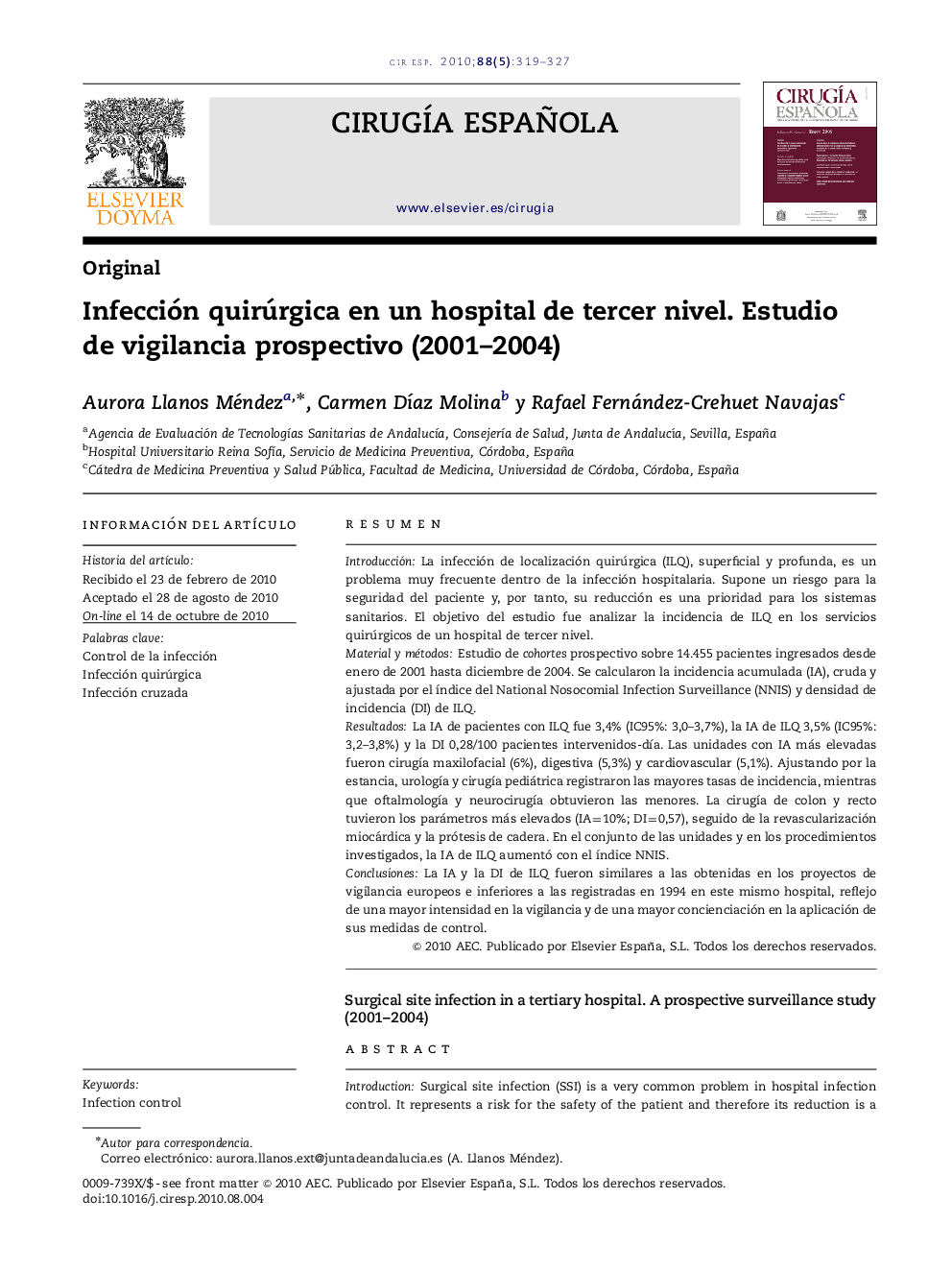| Article ID | Journal | Published Year | Pages | File Type |
|---|---|---|---|---|
| 4252913 | Cirugía Española | 2010 | 9 Pages |
ResumenIntroducciónLa infección de localización quirúrgica (ILQ), superficial y profunda, es un problema muy frecuente dentro de la infección hospitalaria. Supone un riesgo para la seguridad del paciente y, por tanto, su reducción es una prioridad para los sistemas sanitarios. El objetivo del estudio fue analizar la incidencia de ILQ en los servicios quirúrgicos de un hospital de tercer nivel.Material y métodosEstudio de cohortes prospectivo sobre 14.455 pacientes ingresados desde enero de 2001 hasta diciembre de 2004. Se calcularon la incidencia acumulada (IA), cruda y ajustada por el índice del National Nosocomial Infection Surveillance (NNIS) y densidad de incidencia (DI) de ILQ.ResultadosLa IA de pacientes con ILQ fue 3,4% (IC95%: 3,0–3,7%), la IA de ILQ 3,5% (IC95%: 3,2–3,8%) y la DI 0,28/100 pacientes intervenidos-día. Las unidades con IA más elevadas fueron cirugía maxilofacial (6%), digestiva (5,3%) y cardiovascular (5,1%). Ajustando por la estancia, urología y cirugía pediátrica registraron las mayores tasas de incidencia, mientras que oftalmología y neurocirugía obtuvieron las menores. La cirugía de colon y recto tuvieron los parámetros más elevados (IA=10%; DI=0,57), seguido de la revascularización miocárdica y la prótesis de cadera. En el conjunto de las unidades y en los procedimientos investigados, la IA de ILQ aumentó con el índice NNIS.ConclusionesLa IA y la DI de ILQ fueron similares a las obtenidas en los proyectos de vigilancia europeos e inferiores a las registradas en 1994 en este mismo hospital, reflejo de una mayor intensidad en la vigilancia y de una mayor concienciación en la aplicación de sus medidas de control.
IntroductionSurgical site infection (SSI) is a very common problem in hospital infection control. It represents a risk for the safety of the patient and therefore its reduction is a priority in Health Services. The aim of the study is to analyse the incidence of SSI in the surgical departments of a tertiary hospital.Material and methodsA prospective cohort study was conducted on 14,455 patients admitted from January 2001 to December 2004. The cumulative incidence (CI) crude and adjusted for the National Nosocomial Infection Surveillance (NNIS) index and the incidence density (ID) of SSI were calculated.ResultsThe CI of patients with SSI was 3.4% (95% CI: 3.0–3.7%), the CI of SSI was 3.5% and the observed ID was 0.28/100 surgical patients/day. Surgical units with the highest CI were maxillofacial (6%), gastrointestinal (5.3%) and cardiovascular (5.1%). Adjusting for length of stay, urology and paediatric surgery recorded the highest incidence rates, while ophthalmology and neurosurgery had the least. Colorectal surgery had the highest parameters (CI=10%; ID=0.57), followed by myocardial revascularisation and hip prosthesis. Among the surgical units and operative procedures assessed, the CI of SSI increased with the NNIS index.ConclusionsThe CI and ID of SSI observed in this study were similar to those obtained in previous European surveillance projects, and lower than those recorded in our hospital in 1994 which reflects a higher level of vigilance and a higher awareness in applying control measures.
